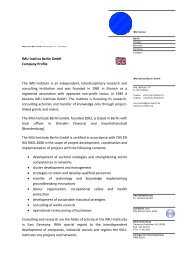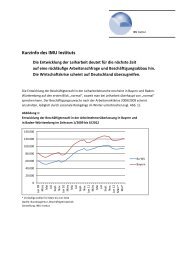Aufzüge und Fahrtreppen - IMU Institut
Aufzüge und Fahrtreppen - IMU Institut
Aufzüge und Fahrtreppen - IMU Institut
Erfolgreiche ePaper selbst erstellen
Machen Sie aus Ihren PDF Publikationen ein blätterbares Flipbook mit unserer einzigartigen Google optimierten e-Paper Software.
Branchenreport<br />
<strong>Aufzüge</strong> <strong>und</strong> <strong>Fahrtreppen</strong> – Branche im Wandel<br />
Dr. Jürgen Dispan 1)<br />
Eine aktuelle Untersuchung zur Situation<br />
<strong>und</strong> Entwicklung der Branche <strong>Aufzüge</strong><br />
<strong>und</strong> <strong>Fahrtreppen</strong> wurde im Sommer 2007<br />
durch das <strong>IMU</strong>-<strong>Institut</strong> Stuttgart vorgelegt.<br />
Die Branche <strong>Aufzüge</strong> <strong>und</strong> <strong>Fahrtreppen</strong><br />
mit ihren r<strong>und</strong> 18 000 Beschäftigten <strong>und</strong><br />
800 Unternehmen ist ein Teilbereich des<br />
Maschinenbaus. Trotz eines hohen Internationalisierungsdrucks<br />
<strong>und</strong> der Schließung<br />
von Produktionsstätten hierzulande<br />
infolge globalisierter Fertigungskonzepte<br />
in den letzten Jahrzehnten ist die Branche<br />
weiterhin ein bedeutender Wirtschaftszweig.<br />
Nicht zuletzt aufgr<strong>und</strong> ihres traditionell<br />
hohen Serviceanteils kann sie als<br />
Pionier im Maschinenbau gelten, wenn<br />
der Wandel von der Produktion zu verstärkter<br />
Dienstleistungsorientierung betrachtet<br />
wird. Darüber hinaus ist die Branche<br />
<strong>Aufzüge</strong> <strong>und</strong> <strong>Fahrtreppen</strong> von starken<br />
Konzentrationsprozessen gekennzeichnet,<br />
die in erster Linie von vier großen Konzernunternehmen<br />
(Big-4) ausgehen.<br />
Ein starker Wandel zeigt sich bei den<br />
Arbeitsplätzen v. a. bei den Big-4, aber<br />
auch bei einigen kleinen <strong>und</strong> mittleren<br />
Unternehmen (KMU) der Branche: Reguläre<br />
Beschäftigung in den Stammbelegschaften<br />
wird ausgedünnt <strong>und</strong> zuneh-<br />
mend abgelöst durch Beschäftigungsformen<br />
wie Leiharbeit, aber auch durch<br />
den Einsatz von Subunternehmen in der<br />
Montage <strong>und</strong> Wartung. Gleichzeitig spielen<br />
bei den Big-4 jeweils Beteiligungsgesellschaften<br />
<strong>und</strong> andere „interne Wettbewerber“<br />
eine immer größere Rolle.<br />
Weitere Faktoren, die im Branchenreport<br />
analysiert werden, sind Innovations-,<br />
Markt- <strong>und</strong> Servicetrends in der Branche.<br />
Diesen <strong>und</strong> vielen weiteren Entwicklungen<br />
<strong>und</strong> Trends im strukturellen Wandel geht<br />
der Branchenreport <strong>Aufzüge</strong> <strong>und</strong> <strong>Fahrtreppen</strong><br />
nach, der vom <strong>IMU</strong>-<strong>Institut</strong> für<br />
die IG Metall <strong>und</strong> das RKW (Rationalisierungs-<br />
<strong>und</strong> Innovationszentrum der Deutschen<br />
Wirtschaft e.V.) erarbeitet wurde.<br />
Der Branchenreport verfolgt das Ziel, eine<br />
f<strong>und</strong>ierte Bestandsaufnahme zur Lage <strong>und</strong><br />
Entwicklung der Branche <strong>Aufzüge</strong> <strong>und</strong><br />
<strong>Fahrtreppen</strong> in Deutschland unter Berücksichtigung<br />
von Markt- <strong>und</strong> Innovationstrends<br />
zu leisten sowie Aussagen zu<br />
Unternehmensstrategien zu generieren. Die<br />
Studie basiert auf einer Auswertung von<br />
Wirtschafts- <strong>und</strong> Beschäftigungsdaten <strong>und</strong><br />
von branchenbezogenen Publikationen.<br />
Darüber hinaus wurde über qualitative<br />
Interviews eine Bestandsaufnahme der<br />
aktuellen Entwicklung in den Unterneh-<br />
men durchgeführt, nicht zuletzt um Herausforderungen<br />
für die Branche <strong>und</strong> ihre<br />
Betriebe abzuleiten <strong>und</strong> um Ansatzpunkte<br />
zur Standortsicherung <strong>und</strong> zur Beschäftigungssicherung<br />
in der Branche <strong>Aufzüge</strong><br />
<strong>und</strong> <strong>Fahrtreppen</strong> in Deutschland zu erarbeiten.<br />
Entwicklung <strong>und</strong> Strukturen der<br />
Branche in Deutschland<br />
Fahrstuhl, Aufzug oder Lift? – schon allein<br />
diese Frage lässt bei Aufzugstechnikern<br />
<strong>und</strong> Branchenexperten Emotionen hochkommen.<br />
Der „Fahrstuhl“ – in der Fachwelt<br />
ein verpönter Begriff – ist sowohl in der<br />
Alltagssprache als auch im Wirtschaftsteil<br />
der Tageszeitungen eine geläufi ge<br />
<strong>und</strong> unverdächtige Bezeichnung für das<br />
vertikale Fortbewegungsmittel, wie zuletzt<br />
bei der umfangreichen Bericht erstattung<br />
zum „Fahrstuhl-Kartell“ gesehen. Auch<br />
die „Rolltreppe“ ist ein umgangssprachlicher<br />
Begriff, weshalb in der Branchenstudie<br />
die Fachbegriffe „Aufzug“ <strong>und</strong><br />
„Fahrtreppe“ verwendet werden.<br />
Seit Anfang 2006 ist die Branche <strong>Aufzüge</strong><br />
<strong>und</strong> <strong>Fahrtreppen</strong> auf Wachstumskurs,<br />
nachdem es zuvor einige schlechtere Jahre<br />
gab. Mit der anziehenden Baukonjunktur<br />
hat sich die Auftragslage sehr gut entwickelt,<br />
bei den Auftragseingängen gab es<br />
allein 2006 ein Plus von 9 %. Damit gibt<br />
es laut VDMA erstmals seit sechs Jahren<br />
wieder positive Wachstumsraten. Alles in<br />
allem ist die Branche <strong>Aufzüge</strong> <strong>und</strong> <strong>Fahrtreppen</strong><br />
ein bedeutender Wirtschaftszweig<br />
in Deutschland. Sie umfasst den Neuanlagenbau,<br />
die Modernisierung sowie<br />
Montage, Service <strong>und</strong> Reparatur von <strong>Aufzüge</strong>n,<br />
<strong>Fahrtreppen</strong> <strong>und</strong> Fahrsteigen. Für<br />
die Branche liegen keine detaillierten Daten<br />
zu Beschäftigung <strong>und</strong> Umsatz vor.<br />
Vorsichtig geschätzt, sind in der Branche<br />
<strong>Aufzüge</strong> <strong>und</strong> <strong>Fahrtreppen</strong> r<strong>und</strong> 18 000<br />
Beschäftigte tätig. In Deutschland gibt es<br />
etwa 800 Unternehmen, die im Bereich<br />
der <strong>Aufzüge</strong> <strong>und</strong> <strong>Fahrtreppen</strong> reparieren,<br />
warten, montieren, modernisieren <strong>und</strong><br />
produzieren. Der Jahresumsatz liegt bei<br />
r<strong>und</strong> 2 Mrd. Euro.<br />
Die Struktur der Branche ist dadurch gekennzeichnet,<br />
dass neben zahlreichen<br />
kleinen <strong>und</strong> mittleren Unternehmen (KMU<br />
mit ca. 40 % Marktanteil) vier Konzern-<br />
1) <strong>IMU</strong>-<strong>Institut</strong> Stuttgart<br />
24 LIFT-REPORT 33. Jahrg. (2007) Heft 6
unternehmen, die sogenannten Big-4 der<br />
Branche (Kone, Otis, Schindler, Thyssen-<br />
Krupp Elevator) mit ihren Beteiligungsgesellschaften<br />
das Marktgeschehen prägen.<br />
Diese vier sind gleichzeitig die einzigen<br />
Unternehmen der Branche in der<br />
Größenklasse über 1 000 Beschäftigte in<br />
Deutschland. Die Big-4 sind nicht nur in<br />
Deutschland, sondern auch weltweit die<br />
vier größten Konzerne der Branche. Sie<br />
bieten sowohl <strong>Aufzüge</strong> als auch <strong>Fahrtreppen</strong><br />
an, daneben gibt es nur noch wenige<br />
Unternehmen, die bei beiden Produktgruppen<br />
aktiv sind.<br />
Die Mehrzahl der kleinen <strong>und</strong> mittleren<br />
Unternehmen ist im Aufzugsbau tätig.<br />
Diese KMU sind häufi g in einer Marktnische<br />
platziert <strong>und</strong>/oder in erster Linie<br />
regional orientiert. Neben ihrer regionalen<br />
Stärke ist ihre Flexibilität <strong>und</strong> K<strong>und</strong>ennähe<br />
hervorzuheben. Aufgr<strong>und</strong> ihrer<br />
Größe bzw. ihrer b<strong>und</strong>esweiten Präsenz<br />
sind bei den KMU die „großen Mittelständler“<br />
Schmitt & Sohn (Nürnberg)<br />
<strong>und</strong> OSMA (Osnabrück) hervorzuheben.<br />
Darüber hinaus gibt es zahlreiche „regionale<br />
Platzhirsche“, die in erster Linie auf<br />
eine mehr oder weniger große Region<br />
ausgerichtet sind. Neben diesen Unternehmen<br />
der Kernbranche gehören zum<br />
Branchenumfeld die Hersteller <strong>und</strong> Anbieter<br />
von Komponenten für <strong>Aufzüge</strong> <strong>und</strong><br />
<strong>Fahrtreppen</strong> sowie die rein im Montageoder<br />
Servicebereich tätigen Kleinstunternehmen,<br />
die mitunter nur einen Arbeitsplatz<br />
bieten.<br />
Arbeitsplätze<br />
Für „<strong>Aufzüge</strong> <strong>und</strong> <strong>Fahrtreppen</strong>“ als Teilbereich<br />
der Wirtschaftsklasse „Herstellung<br />
von Hebezeugen <strong>und</strong> Fördermitteln“<br />
weist die amtliche Statistik keine Daten<br />
zur Anzahl der Arbeitsplätze aus. Laut<br />
den eigenen Erhebungen ist in Deutschland<br />
von einer Beschäftigtenzahl von<br />
r<strong>und</strong> 18 000 in der Branche auszugehen.<br />
In den letzten Jahren ging die Anzahl der<br />
Arbeitsplätze jedoch stark zurück: Einerseits<br />
wurden die zwei große <strong>Fahrtreppen</strong>werke<br />
von Otis <strong>und</strong> Kone sowie weitere<br />
Produktionsstätten im Aufzugsbau geschlossen,<br />
andererseits wurden Arbeitsplätze<br />
in der Kernbelegschaft der Unternehmen<br />
(z. B. in Montage <strong>und</strong> Service bei<br />
den Big-4) abgebaut.<br />
Weltmarktanteile<br />
Weltweit besteht in der Branche <strong>Aufzüge</strong><br />
<strong>und</strong> <strong>Fahrtreppen</strong> eine erhebliche Konzentration,<br />
die sich als Folge der globalen<br />
Präsenz bei den Aufzugs- <strong>und</strong> <strong>Fahrtreppen</strong>bauern<br />
ergibt: Auf die sechs größten<br />
Hersteller Otis, Schindler, ThyssenKrupp,<br />
Kone, Mitsubishi <strong>und</strong> Hitachi entfallen<br />
84 % des Weltmarktes <strong>und</strong> auch ein Löwenanteil<br />
des europäischen Marktes. Im inter-<br />
Hitachi<br />
7 %<br />
Mitsubishi<br />
8 %<br />
Sonstige<br />
16 %<br />
Kone<br />
11 %<br />
<strong>Aufzüge</strong> <strong>Fahrtreppen</strong><br />
ThyssenKrupp<br />
13 %<br />
Schindler<br />
18 %<br />
Quelle: Handelsblatt vom 22.02.2007; Schindler Tätigkeitsbericht 2006<br />
Abbildung: Weltmarkt für <strong>Aufzüge</strong> <strong>und</strong> für <strong>Fahrtreppen</strong> – Marktanteile in %<br />
26 LIFT-REPORT 33. Jahrg. (2007) Heft 6<br />
Otis<br />
27%<br />
nationalen Rahmen ist der Wettbewerb<br />
dieser „global player“ nach wie vor sehr<br />
ausgeprägt, wenn hieran auch aufgr<strong>und</strong><br />
der von der Europäischen Kommission<br />
festgestellten Kartellverstöße Zweifel<br />
aufgekommen sind. Auf den spezifi schen<br />
Märkten der Weltregionen erweitert sich<br />
der Kreis der Wettbewerber jeweils um<br />
die nationalen <strong>und</strong> regionalen Anbieter,<br />
die versuchen, im Kampf um Marktanteile<br />
den „global player“ Paroli zu bieten.<br />
Konzentrationsprozesse <strong>und</strong><br />
„Kreislaufwirtschaft“<br />
Bereits seit Jahrzehnten ist die Branchenstruktur<br />
<strong>und</strong> -dynamik gekennzeichnet<br />
von Fusionen <strong>und</strong> der Übernahme von<br />
Unternehmen, v. a. durch die Big-4. Ein Zitat<br />
aus der Homepage der Vereinigung<br />
mittelständischer Aufzugsunternehmen<br />
spricht für sich: „1970 sagte ein Aufkäufer<br />
eines Aufzugskonzerns: In fünf Jahren<br />
wird es in Deutschland nur noch fünf<br />
Aufzugsfi rmen geben. Er hat sich geirrt“<br />
(www.vma.de). Die Übernahme von KMU<br />
ist für die großen Unternehmen mit dem<br />
strategischen Ziel verb<strong>und</strong>en, deren Wartungsverträge<br />
zu übernehmen <strong>und</strong> damit<br />
das eigene Servicegeschäft auszubauen.<br />
Die Integration der KMU läuft in<br />
der Regel nach dem Muster ab, dass deren<br />
Fertigung kurz- bis mittelfristig geschlossen<br />
wird <strong>und</strong> bestenfalls eine kleine Werkstatt<br />
übrig bleibt. Auf der anderen Seite<br />
gibt es immer wieder Neugründungen<br />
von Kleinbetrieben, oft aus bestehenden<br />
Aufzugsbau-Unternehmen heraus, deren<br />
Geschäftsfeld meist bei Service <strong>und</strong>/oder<br />
Montage liegt, so dass manche von einer<br />
„Kreislaufwirtschaft“ in der Branche sprechen.<br />
Der Wettbewerbsdruck, unter dem die<br />
Branche <strong>Aufzüge</strong> <strong>und</strong> <strong>Fahrtreppen</strong> auf internationaler<br />
<strong>und</strong> nationaler Ebene steht,<br />
ist erheblich. Aggressive Wettbewerbsstrategien<br />
<strong>und</strong> ein harter Preiswettbewerb<br />
Hitachi<br />
6 %<br />
Mitsubishi<br />
8 %<br />
Sonstige<br />
16 %<br />
Kone<br />
12 %<br />
ThyssenKrupp<br />
12 %<br />
Otis<br />
20%<br />
Schindler<br />
26 %<br />
führten in den letzten Jahren zu einem<br />
starken Preisverfall in allen drei hauptsächlichen<br />
Geschäftsfeldern der Unternehmen:<br />
bei Neuanlagen, bei der Modernisierung<br />
<strong>und</strong> inzwischen auch bei der<br />
Instandhaltung . Dem Verdrängungswettbewerb<br />
sind in erster Linie viele mittelständische<br />
Aufzugsbauer nicht gewachsen,<br />
was neben anderen Faktoren nicht<br />
selten dazu führt, dass sie von einem der<br />
vier großen Unternehmen der Aufzugsindustrie<br />
aufgekauft <strong>und</strong> eingegliedert<br />
werden. Insgesamt gibt es eine unübersehbare<br />
Konzentration auf dem deutschen<br />
Aufzugsmarkt, wo Firmenaufkäufe<br />
in den letzten Jahren zu einer deutlichen<br />
Verdichtung des Angebots geführt haben.<br />
Wachstum <strong>und</strong> Wettbewerb<br />
im Service<br />
Die Branche <strong>Aufzüge</strong> <strong>und</strong> <strong>Fahrtreppen</strong><br />
weist einen für das Verarbeitende Gewerbe<br />
im allgemeinen <strong>und</strong> für den Maschinenbau<br />
im speziellen sehr hohen Serviceanteil<br />
auf. Von vielen Unternehmen der<br />
Branche wird bereits seit langem das gesamte<br />
Spektrum vom industriell oder<br />
handwerklich gefertigten Produkt bis zum<br />
Service angeboten. Für den Maschinenbau<br />
<strong>und</strong> für einige weitere Industriezweige in<br />
Deutschland wird eine Verknüpfung von<br />
Produktion <strong>und</strong> Dienstleistungen immer<br />
bedeutender. Die Aufzugsbranche kann<br />
hier durchaus als Pionier einer vermehrten<br />
Dienstleistungsorientierung im Maschinenbau<br />
gelten; sie ist in einer Vorreiterrolle<br />
in Bezug auf den Weg klassischer<br />
Industriezweige von der Warenproduktion<br />
zum Dienstleistungsanbieter. Bereits vor<br />
20 Jahren verfasste Johannes Schmitt,<br />
heutiger Geschäftsführer von Schmitt &<br />
Sohn, seine Dissertation mit dem Titel<br />
„Entwicklung der Aufzugbranche von der<br />
Warenproduktion zum Dienstleistungsanbieter“<br />
(Schmitt 1988).
Service ist ein starker Wachstumsbereich<br />
in der Branche. In der Produktionsstatistik<br />
wird die „Reparatur von <strong>Aufzüge</strong>n <strong>und</strong><br />
<strong>Fahrtreppen</strong>“ erst seit 2002 erfasst. Im<br />
kurzen Zeitraum von nur drei Jahren stieg<br />
der Anteil des Services an der Gesamtproduktion<br />
von 36 % auf 48 %. Hier kommt<br />
auch die hohe strategische Bedeutung zum<br />
Ausdruck, die der Ausbau des Servicegeschäfts<br />
für die Aufzugsbauer hat. Die<br />
Branchenentwicklung ist in erster Linie<br />
abhängig von den Bauinvestitionen <strong>und</strong><br />
unter liegt daher zyklischen Schwankungen.<br />
Das Neuanlagengeschäft war bis 2005<br />
durch die Investitionsschwäche unter<br />
Druck geraten, wogegen sich der immer<br />
wichtigere Servicebereich relativ konjunkturresistent<br />
zeigte. Gerade während<br />
der Krisenjahre der Bauwirtschaft bis<br />
2005, also in nachfrageschwachen Zeiten,<br />
war ein starkes Standbein im Servicegeschäft<br />
für die Unternehmen wichtig, um<br />
Umsatzausfälle im Neuanlagenbau kompensieren<br />
zu können. Insgesamt ist das<br />
Servicegeschäft weitgehend konjunkturunabhängig<br />
<strong>und</strong> für die Unternehmen<br />
bislang auch fi nanziell lukrativer. Deshalb<br />
werden beim Verkauf neuer <strong>Aufzüge</strong> <strong>und</strong><br />
<strong>Fahrtreppen</strong> mitunter wenig auskömmliche<br />
Preise hingenommen, wenn mit<br />
dem Auftrag ein möglichst langfristiger<br />
Servicevertrag verb<strong>und</strong>en ist. Seit 2005<br />
verschärft sich jedoch im Service der<br />
Preiswettbewerb immens, so dass inzwischen<br />
auch bei den Wartungsverträgen<br />
die Deckungsbeiträge geringer werden.<br />
Damit wird die Subventionierung des<br />
Neuanlagengeschäfts (um an Wartungsverträge<br />
zu kommen) als Herangehensweise<br />
der Unternehmen zunehmend in<br />
Frage gestellt.<br />
Das strategische Oberziel bei den Big-4<br />
kann mit „Wachstum“ auf den Punkt gebracht<br />
werden. Alle vier Konzernunternehmen<br />
wollen vor allem beim Service<br />
schneller wachsen als die Wettbewerber<br />
<strong>und</strong> die Zahl ihrer Wartungsverträge steigern.<br />
Dies drückt sich in Leitlinien <strong>und</strong><br />
Strategien aus wie „Leadership through<br />
Service“ (Schindler), „1. in Service“ (Otis),<br />
„Global Service Strategie“ (ThyssenKrupp)<br />
<strong>und</strong> „VISION“ (Kone).<br />
Der Gewinn von Marktanteilen kann in der<br />
Branche <strong>Aufzüge</strong> <strong>und</strong> <strong>Fahrtreppen</strong> fast nur<br />
durch Unternehmensakquisitionen erreicht<br />
werden. Wichtigste Wachstumsstrategie<br />
ist daher der Zukauf von anderen Aufzugsbauern<br />
mit ihren Wartungsverträgen.<br />
Der Schwerpunkt dieser Akquisitionen lag<br />
zwar in den letzten Jahren in den Wachstumsmärkten<br />
Osteuropas <strong>und</strong> Asiens, aber<br />
auch in Deutschland haben alle vier Großunternehmen<br />
einige KMU aufgekauft.<br />
Diese Strategie wird seit Jahren verfolgt<br />
<strong>und</strong> könnte sich in den nächsten Jahren<br />
nochmals verschärfen.<br />
Sonst. KMU<br />
32 %<br />
OSMA<br />
3 %<br />
Schmitt+Sohn<br />
5 % Kone<br />
9 %<br />
Ist-Stand 2006 2010 – Wachstumsszenarien der Big-4<br />
Schindler<br />
22 %<br />
ThyssenKrupp<br />
12 %<br />
Abbildung: Servicegeschäft in Deutschland bei <strong>Aufzüge</strong>n <strong>und</strong> <strong>Fahrtreppen</strong><br />
Ein bedeutendes Strategiefeld im Servicebereich<br />
liegt bei den sogenannten Fremdwartungen.<br />
Wartungsarbeiten an <strong>Aufzüge</strong>n<br />
anderer Hersteller („third party<br />
maintenance“) sind ein Kernelement der<br />
neuen, expansiven Servicestrategien. Die<br />
Wartung älterer <strong>Aufzüge</strong> anderer Hersteller<br />
ist für die Monteure weitgehend<br />
problemlos zu machen, zumal Wartung<br />
in erster Linie die mechanischen Bauteile<br />
umfasst. Neuere Anlagen sind dagegen<br />
eher problematisch, zumal wenn sie über<br />
„geschlossene Steuerungen“ verfügen,<br />
auf die nur die Monteure des Herstellers<br />
Zugriff haben. Aber auch diese können<br />
von den Wettbewerbern technisch „geknackt“<br />
werden – in den Schulungszentren<br />
der Big-4 werden Monteure gezielt<br />
für die Arbeit an Fremdsteuerungen<br />
Quelle: Unternehmensangaben <strong>und</strong> <strong>IMU</strong>-Schätzungen<br />
geschult. Oder die Steuerungen werden<br />
mit eigenen Komponenten nachgerüstet.<br />
Gleichzeitig werden Fremdwartungen<br />
dadurch erleichtert, dass große Auftraggeber<br />
bei ihren Ausschreibungen einheitliche,<br />
auf dem freien Markt verfügbare<br />
Steuerungen fordern, um bei der Vergabe<br />
der Wartungsverträge fl exibel zu sein. In<br />
der Praxis ist das Angebot von Fremdwartungen<br />
ein schwieriges Feld für den Vertrieb,<br />
wenn auch inzwischen eigens Schulungen<br />
angeboten werden <strong>und</strong> der Markt<br />
aggressiv mit unterschiedlichen Marketingtools<br />
wie Mailing- <strong>und</strong> Call-Center-<br />
Aktionen bearbeitet wird. Nicht nur die<br />
Big-4, auch KMU-Aufzugsbauer setzen<br />
verstärkt auf die Wartung von Fremdanlagen<br />
– ein Paradigmenwechsel zeichnet<br />
sich ab: In der Branche gab es den Kodex,<br />
LIFT-REPORT 33. Jahrg. (2007) Heft 6 27<br />
Otis<br />
17%<br />
OSMA<br />
3 %<br />
Schmitt+Sohn<br />
5 %<br />
Sonst. KMU<br />
22 %<br />
Kone<br />
12 %<br />
ThyssenKrupp<br />
15 %<br />
Schindler<br />
24 %<br />
Otis<br />
19%
dass Wartungsverträge in erster Linie nur<br />
für eigene Anlagen abgeschlossen werden.<br />
Dieser Gr<strong>und</strong>satz wird derzeit aufgebrochen.<br />
Einerseits weil nachfrageseitig immer<br />
häufi ger Komplettpakete mit <strong>Aufzüge</strong>n<br />
unterschiedlicher Hersteller ausgeschrieben<br />
werden, andererseits auch weil die<br />
großen Wettbewerber immer aggressiver<br />
bei der Akquisition von Fremdanlagen<br />
werden. Zwar ist die Fremdanlagenwartung<br />
bei vielen KMU (noch) kein Strategiekonzept,<br />
sondern eher der Einzelfall.<br />
Aber die Hemmschwelle wird sukzessive<br />
heruntergesetzt <strong>und</strong> es gibt erste Schritte<br />
einer verstärkten Marktbearbeitung in<br />
diese Richtung. Inzwischen wird von<br />
manchem KMU-Aufzugsbauer auch in<br />
der Werbung deutlich gemacht, dass<br />
auch Fremdanlagen gewartet werden.<br />
Internationalisierung<br />
Die Internationalisierung der Branche ist<br />
auf der Fertigungsseite sehr ausgeprägt.<br />
Internationalisierte Fertigungskonzepte<br />
haben beim Aufzugsbau dazu geführt,<br />
dass in Deutschland nur noch wenige<br />
größere Aufzugswerke übriggeblieben<br />
sind, darunter das ThyssenKrupp Aufzugswerk<br />
in Neuhausen bei Stuttgart als<br />
größtes Aufzugswerk Europas <strong>und</strong> die<br />
Werke der beiden großen Mittelständler<br />
OSMA in Osnabrück <strong>und</strong> Schmitt & Sohn<br />
in Nürnberg. Bei den <strong>Fahrtreppen</strong>werken<br />
blieb nach den Produktionsverlagerungen<br />
<strong>und</strong> Schließungen der letzten Jahre (Otis<br />
in Stadthagen, Kone in Hattingen) nur<br />
noch ein größeres Werk übrig: das Thyssen-<br />
Krupp <strong>Fahrtreppen</strong>werk in Hamburg. Die<br />
Big-4 in Deutschland sind Teil von weltweit<br />
aufgestellten Konzernen mit Nieder-<br />
lassungen <strong>und</strong> Werken in allen relevanten<br />
Märkten. Neben der Expansion in Osteuropa<br />
liegt das Schwergewicht auf Asien,<br />
wo es die höchsten Zuwachsraten gibt.<br />
Gleichzeitig haben sich die Komponentenmärkte<br />
internationalisiert <strong>und</strong> auch<br />
die KMU-Aufzugsbauer haben ihren Komponenteneinkauf<br />
zumindest europäisiert.<br />
Innovationen<br />
In der Diskussion um zukünftige Beschäftigungssicherung<br />
<strong>und</strong> Wettbewerbsfähigkeit<br />
von Unternehmen in Deutschland<br />
ist Innovation einer der zentralen Gesichtspunkte.<br />
Auch für die Branche <strong>Aufzüge</strong> <strong>und</strong> <strong>Fahrtreppen</strong><br />
gilt, dass es kontinuierlicher Innovationsanstrengungen<br />
bedarf, um angesichts<br />
internationaler Konkurrenz weiterhin<br />
wettbewerbsfähig zu sein. Das Innovationsgeschehen<br />
ist in dieser Branche<br />
stark an europäische <strong>und</strong> nationale<br />
Rechts vorgaben, Normen <strong>und</strong> Richtlinien<br />
gekoppelt. Im europäischen Rahmen hat<br />
sich durch eine neue Konzeption (als<br />
Beitrag zur Deregulierung in Europa) <strong>und</strong><br />
entsprechende gesetzgeberische Maßnahmen<br />
seit gut zehn Jahren in der zuvor<br />
eher konservativen <strong>und</strong> innovationsschwachen<br />
Branche eine starke Innovationsdynamik<br />
entwickelt. Verschiedene Innovationen<br />
hatten in den letzten Jahren<br />
erhebliche Konsequenzen auf die Aufzugstechnik<br />
<strong>und</strong> auf die Gebäudegestaltung.<br />
Vor allem die triebwerksraumlosen <strong>Aufzüge</strong><br />
(MRL) haben den Aufzugsmarkt<br />
stark verändert. Insgesamt hat die Einführung<br />
der Europäischen Aufzugsrichtlinie<br />
sowie weiterer Normen, Regelungen<br />
<strong>und</strong> Sicherheitsanforderungen eine ganze<br />
Reihe von Produktinnovationen initiiert<br />
<strong>und</strong> ermöglicht. Unter strategischen<br />
Gesichtspunkten hervorzuheben ist die<br />
Über nahme europäischer Normen in weiteren<br />
Staaten, die die Markterschließung<br />
erleichtert. So wird bspw. die EN 115<br />
(<strong>Fahrtreppen</strong>, Fahrsteige) auch in China,<br />
Australien, Afrika, Südamerika <strong>und</strong> Osteuropa<br />
angewendet.<br />
Der Innovationsbegriff sollte nicht auf<br />
den Bereich der technischen Produktinnovation<br />
verengt werden. Neben den Produkten<br />
werden bei einem umfassenden,<br />
ganzheitlichen Innovationsverständnis<br />
auch Dienstleistungen, technische Prozesse<br />
<strong>und</strong> Organisationsstrukturen einbezogen.<br />
Damit werden in der Langfassung<br />
des Branchenreports nicht nur<br />
gr<strong>und</strong>legende technische Produktinnovationen<br />
wie der triebwerksraumlose Aufzug<br />
betrachtet, sondern auch Produktinnovationen<br />
im Bereich des Service sowie<br />
Prozessinnovationen in Fertigung<br />
<strong>und</strong> Organisation. Zum weiten Feld der<br />
Innovationen gehören damit auch Themen<br />
wie bedarfsorientierte Wartung,<br />
modularisierte Wartung, Ferndiagnose,<br />
ganzheitliche Produktionssysteme, Standardisierung<br />
<strong>und</strong> Modularisierung als<br />
Produktstrategien etc.<br />
KMU-Aufzugsbauer im Anpassungsprozess<br />
Auch viele kleine <strong>und</strong> mittlere Unternehmen<br />
der Branche befi nden sich wie die<br />
Big-4 seit Jahren in Restrukturierungsprozessen.<br />
Diese sind in erster Linie bedingt<br />
durch den immer stärkeren Verdrängungswettbewerb<br />
im Neuanlagen- <strong>und</strong><br />
Modernisierungsgeschäft, aber auch im<br />
28 LIFT-REPORT 33. Jahrg. (2007) Heft 6
Service. Harter Preiswettbewerb <strong>und</strong><br />
Kon zentrationsprozesse begleiten die<br />
Branche seit Jahren. Besonders schmerzhaft<br />
für manchen KMU-Aufzugsbauer<br />
waren die Standardisierungsprogramme<br />
der Big-4, die damit einhergehende Beherrschung<br />
des Volumenmarkts, auch<br />
im Zusammenhang mit dem Siegeszug<br />
von MRL-Konzepten, <strong>und</strong> die Zurückdrängung<br />
der Hydraulikaufzüge. Viele KMU-<br />
Aufzugsbauer gerieten dadurch in den<br />
letzten Jahren in eine Schiefl age, die bei<br />
manchen in eine echte Unternehmenskrise<br />
mündete. Darauf mussten die kleinen<br />
<strong>und</strong> mittleren Unternehmen reagieren,<br />
z. B. indem noch stärker auf eine<br />
Nischenstrategie fokussiert wurde oder<br />
indem bei der Fertigung rationalisiert<br />
<strong>und</strong> outgesourct wurde, oft im Zusammenhang<br />
mit einer Spezialisierung auf<br />
einzelne Komponenten <strong>und</strong> dem vermehrten<br />
Zukauf der weiteren Bauteile.<br />
Standardisierung <strong>und</strong> Baukastensysteme<br />
sind auch bei den KMU-Aufzugsbauern<br />
nicht mehr wegzudenken. Gerade<br />
die größeren unter ihnen haben in<br />
der Regel ein eigenes „standardisiertes<br />
Basisprogramm“. Kleinere Aufzugsbauer<br />
greifen dagegen häufi g auf die Anbieter<br />
von Komplettanlagen unter den<br />
Komponentenherstellern zurück. Immer<br />
mehr Komponentenhersteller folgen<br />
dem Trend des Marktes, alles aus einer<br />
Hand zu beziehen <strong>und</strong> entwickeln sich<br />
zum Systemlieferanten. Baukastensysteme<br />
sind jedoch nur eine Seite der Medaille,<br />
gerade bei den KMU-Aufzugsbauern<br />
sind Sonderaufzüge eine mindestens<br />
genauso wichtige zweite Seite<br />
der Medaille.<br />
KMU-Aufzugsbauer sind in der Regel<br />
auf eine bestimmte Region spezialisiert<br />
(„regionaler Platzhirsch mit gutem Namen<br />
<strong>und</strong> Image“) <strong>und</strong>/oder strategisch<br />
auf spezielle Felder ausgerichtet (Nischenstrategie).<br />
Bei diesen KMU setzen<br />
vor allem die Betriebe mit Eigenfertigung<br />
bzw. mit einer relativ hohen Fertigungstiefe<br />
auf Sonderaufzüge <strong>und</strong> auf individuelle,<br />
maßgeschneiderte Lösungen. Entsprechend<br />
sind die Spezialitäten dieser<br />
Auf zugsbauer z. B. die „Stückzahl 1“, <strong>und</strong>/<br />
oder sie liegen z. B. im Bereich des Panoramaaufzugs,<br />
Schiffsaufzugs, Schrägaufzugs<br />
etc. Teilweise liegt in einer solchen<br />
Nischenstrategie ein Hauptgeschäftsfeld<br />
, das durch ein zweites Feld<br />
Standardaufzug ergänzt wird. Alles in<br />
allem sind die Stärken vieler KMU-Aufzugsbauer<br />
stark mit ihrer K<strong>und</strong>ennähe<br />
verb<strong>und</strong>en, sie liegen in einer ausgeprägten<br />
K<strong>und</strong>enorientierung <strong>und</strong> der<br />
Möglichkeit, auf K<strong>und</strong>enwünsche besser<br />
einzugehen <strong>und</strong> Spezifi zierungen<br />
am Produkt zu ermöglichen. Daneben<br />
liegen ihre Pluspunkte in der Flexibilität,<br />
schnellen Reaktionsfähigkeit <strong>und</strong> Verlässlichkeit.<br />
Ein weiteres Plus sind die<br />
qualifi zierten Verkäufer, die als technische<br />
Berater die Modifi kationen des<br />
K<strong>und</strong>en direkt aufgreifen <strong>und</strong> in den<br />
Produktentwurf einfl ießen lassen.<br />
Komponentenhersteller<br />
Ein immer wichtiger werdender Bestandteil<br />
der Branche sind die Komponentenhersteller<br />
<strong>und</strong> die Anbieter von<br />
Komponenten (Vollsortimenter). Umso<br />
mehr sich die Fertigungstiefe bei vielen<br />
traditionellen Aufzugsbauern verringert,<br />
desto höher wird der Fertigungsanteil<br />
der Komponentenhersteller, die sich zunehmend<br />
europa- <strong>und</strong> weltweit aufstellen.<br />
Ein Ausgangspunkt für die Entwicklung<br />
der Komponentenindustrie waren<br />
auch die internationalen Fertigungskonzepte<br />
mit Komponentenspezialisierung<br />
der Big-4. Die unabhängigen Komponentenhersteller<br />
konzentrierten sich zunächst<br />
auf Einzelkomponenten wie z. B.<br />
Türen, Hydraulik antriebe, Steuerungen<br />
etc. Bei einigen Komponentenlieferanten<br />
ist der Trend zum Systemlieferanten<br />
festzustellen: Bereits seit einigen Jahren<br />
sind bei den bisher eingeführten im Aufzugsbau<br />
tätigen Zulieferunternehmen<br />
vermehrt Bausatz-<strong>und</strong> Systemlösungen<br />
festzustellen, die weit über das ursprüngliche<br />
Angebotssegment hinausgehen.<br />
Vor allem diese Komponenten-Vollsortimenter<br />
konnten in den letzten Jahren<br />
ihre Marktpräsenz stark erhöhen.<br />
Inzwischen gibt es eine ganze Reihe von<br />
Vollsortimentern, die z. B. den kleinen<br />
Auf zugsmontagebetrieben (ohne Planungsabteilung)<br />
komplette Aufzugsanlagen<br />
mit kompletter Dokumentation<br />
anbieten.<br />
Trends bei Beschäftigung <strong>und</strong><br />
Arbeitsbedingungen<br />
Die Zahl der Arbeitsplätze in der Branche<br />
<strong>Aufzüge</strong> <strong>und</strong> <strong>Fahrtreppen</strong> geht zurück,<br />
nicht zuletzt aufgr<strong>und</strong> der Werkschließungen<br />
der letzten Jahre. Es liegt<br />
auf der Hand, dass vor dem Hintergr<strong>und</strong><br />
von Produktionsverlagerungen vor allem<br />
in der Fertigung Arbeitsplätze abgebaut<br />
wurden. Mithin gibt es bei Branchenbetrachtung<br />
allein deshalb schon einen<br />
Trend hin zu höheren Anteilen bei den<br />
Angestellten, der aber auch betriebsbezogen,<br />
innerhalb der verbliebenen Fertigungsstätten,<br />
feststellbar ist. Neben<br />
schließungsbedingten Kündigungen gab<br />
es bei den Big-4 auch einen schleichenden<br />
Abbau von Arbeitsplätzen in<br />
vielen Bereichen. Bei den Monteuren<br />
muss differenziert werden: Rein quantitativ,<br />
von der Anzahl der Arbeitsplätze<br />
her, dürfte der Beschäftigungsstand in<br />
den letzten Jahren in betriebsübergreifender<br />
Sicht gehalten worden sein. Hier<br />
gab es aber immense Verschiebungen<br />
LIFT-REPORT 33. Jahrg. (2007) Heft 6 29
ei der Qualität der Arbeitsverhältnisse:<br />
Neuanlagenmonteure wurden bei den<br />
Kernunternehmen abgebaut, deren Aufgabe<br />
wird heute vielfach von Subunternehmen<br />
mit schlechteren Arbeits- <strong>und</strong><br />
Entlohnungsbedingungen erledigt.<br />
Bei den KMU-Aufzugsbauern gibt es –<br />
wenn man die „Erosion durch Zukauf der<br />
Big-4“ ausklammert – viele Unternehmen,<br />
die trotz schwieriger Zeiten bis 2005<br />
ihre Arbeitsplätze weitgehend gehalten<br />
haben. Bei manchen kam es jedoch zu<br />
krisenbedingten Einschnitten, die auch zu<br />
betriebsbedingten Kündigungen führten.<br />
Der Arbeitsplatzabbau traf in erster Linie<br />
gewerbliche Beschäftigte, oft Ungelernte<br />
<strong>und</strong> Hilfskräfte in der Fertigung. Aus<br />
heutiger Sicht sind, insbesondere bei Servicemonteuren,<br />
Überst<strong>und</strong>en <strong>und</strong> volle<br />
Arbeitszeitkonten auf der Tagesordnung.<br />
Ein relativ neuer, sich verstärkender Trend<br />
bei der Beschäftigung ist die Ausweitung<br />
prekärer Arbeitsformen. Durch den Einsatz<br />
von Leiharbeitern in Fertigung <strong>und</strong><br />
Montage sowie durch Fremdvergabe bei<br />
der Montage von Neuanlagen <strong>und</strong> bei der<br />
Modernisierung wird reguläre Beschäftigung<br />
zunehmend bedroht.<br />
Gleichzeitig verschärfen sich die Arbeitsbedingungen<br />
der Monteure. Neue Wartungskonzepte<br />
<strong>und</strong> kürzere Zeitvorgaben<br />
führen bei den Servicemonteuren zu massiver<br />
Arbeitsverdichtung.<br />
Arbeitsschutz<br />
Allein die Meldungen von Unfällen, die<br />
bei der Benutzung von <strong>Aufzüge</strong>n <strong>und</strong><br />
<strong>Fahrtreppen</strong> <strong>und</strong> bei der Arbeit an den<br />
Anlagen passieren, zeigen die hohe Bedeutung,<br />
die dem Thema Arbeitsschutz<br />
in der Branche zukommen sollte. Diese an<br />
sich hohe Wertigkeit ist in der Praxis nicht<br />
immer gegeben. Von massiven Problemen<br />
<strong>und</strong> Verstößen gegen die Arbeitssicherheit<br />
wird bei Subunternehmen berichtet,<br />
die beim Neuanlagenbau <strong>und</strong> bei der<br />
Modernisierung von Anlagen zum Zuge<br />
kommen. Aber auch generell sind bei den<br />
Monteuren weiterhin Arbeitsschutzmaßnahmen<br />
<strong>und</strong> permanente Überzeugungsarbeit<br />
notwendig. Ein besonderes Augenmerk<br />
ist beim Thema Arbeitsschutz auf<br />
die immer stärker verbreiteten triebwerksraumlosen<br />
<strong>Aufzüge</strong> zu richten. Wegen<br />
des fehlenden Triebwerksraums <strong>und</strong><br />
dem inzwischen häufi g zusätzlich verkürzten<br />
Schachtkopf/-grube gibt es bei<br />
den MRL-<strong>Aufzüge</strong>n konstruktionsbedingte<br />
Arbeitserschwernisse, die die Sicherheit<br />
der Beschäftigten im Servicebereich einschränken.<br />
Die Verletzungs- <strong>und</strong> Unfallgefahr<br />
ist viel höher als bei den alten Antriebskonzepten.<br />
Gefährdungen für Servicemonteure entstehen<br />
durch die schwerere Zugänglich-<br />
keit von Bauteilen, durch den verkürzten<br />
Schachtkopf, der im Notfall schnell zu<br />
Quetschungen führen kann. MRL-<strong>Aufzüge</strong><br />
sollten daher in wesentlichen Punkten<br />
verbessert werden. Wenn diese Notwendigkeit<br />
aus reinen Kostenfaktoren nicht<br />
erfüllt wird, kann die Ausbreitung neuer<br />
Arten von <strong>Aufzüge</strong>n leicht zu einem unerwarteten<br />
Ansteigen von Unfallopfern<br />
bei den Beschäftigten im Servicebereich<br />
der <strong>Aufzüge</strong> führen (vgl. Lift-Report 4-<br />
2006, S. 4-8).<br />
Ausblick<br />
Die Branche <strong>Aufzüge</strong> <strong>und</strong> <strong>Fahrtreppen</strong> ist<br />
in jüngerer Vergangenheit <strong>und</strong> wohl auch<br />
in Zukunft geprägt von einer starken<br />
Dynamik bei Beschäftigungs-, Markt- <strong>und</strong><br />
Innovationstrends. Die Kombination aus<br />
Preiswettbewerb <strong>und</strong> Wachstumsstrategien<br />
wird weiterhin Konzentrationsprozesse<br />
befördern. Internationalisierungsstrategien<br />
bei Produktion <strong>und</strong> Beschaffung<br />
werden die Entwicklung der verbliebenen<br />
Fertigung weiterhin beeinfl ussen.<br />
Strategien zur Erhöhung der Innovationsfähigkeit<br />
in technischer <strong>und</strong> organisatorischer<br />
Hinsicht, bei Produkten <strong>und</strong><br />
Prozessen , sind gerade auch für KMU-<br />
Aufzugsbauer notwendig, um im Wettbewerb<br />
zu bestehen. Auch Standardisierung<br />
<strong>und</strong> Modularisierung werden entscheidende<br />
Themen bleiben, die aber nicht<br />
zulasten von Individuallösungen <strong>und</strong> Flexibilität<br />
vorangetrieben werden sollten; es<br />
gilt hier anspruchsvolle <strong>und</strong> qualitativ<br />
hoch wertige Konzepte umzusetzen. Von<br />
großer Bedeutung ist insbesondere der<br />
weitere Wandel im Service, wo hoher Veränderungsdruck<br />
auf Arbeitsinhalte, Wartungszeiten,<br />
Arbeitsmittel <strong>und</strong> das Selbstverständnis<br />
der Monteure zu erwarten<br />
ist. Auch ist zu befürchten, dass sich Beschäftigung<br />
weiterhin weg vom klassischen<br />
Normalarbeitsverhältnis entfernt<br />
<strong>und</strong> zunehmend Prekarisierungskonzepte<br />
mit Leiharbeit <strong>und</strong> Fremdvergabe die<br />
Arbeitspolitik bestimmen.<br />
Beschäftigungsrisiken gibt es damit in<br />
zweierlei Richtungen: In quantitativer<br />
Hinsicht liegen die Risiken für die Beschäftigung<br />
in der Branche in weiterem<br />
Personalabbau in Fertigung, Verwaltung<br />
<strong>und</strong> Service durch Fremdvergabe, Auslandsverlagerung,<br />
Rationalisierung <strong>und</strong><br />
Arbeitsverdichtung. Weitere Akquisitionen<br />
durch die Konzernunternehmen bergen<br />
das Risiko, dass wie vielfach vorexerziert<br />
Fertigungsarbeitsplätze in den zugekauften<br />
Unternehmen radikal abgebaut werden.<br />
In qualitativer Hinsicht besteht für<br />
die Beschäftigten die Gefahr einer weiteren<br />
Verschärfung der Arbeitsbedingungen<br />
<strong>und</strong> der Segmentierung in Hochqualifi<br />
zierte, die wie bisher entlohnt werden<br />
<strong>und</strong> einfachere Arbeitsplätze, die<br />
niedriger eingruppiert sind. Sowohl in<br />
Produktionsstätten als auch im Service<br />
gibt es bereits entsprechende Tendenzen.<br />
Die weitere Verbreitung von Leiharbeit<br />
wird die Stammbelegschaften zunehmend<br />
unter Druck setzen.<br />
Die aktuelle wirtschaftliche Situation <strong>und</strong><br />
die weitere wirtschaftliche Entwicklung<br />
wurde von den im Rahmen der Branchenstudie<br />
Befragten gr<strong>und</strong>sätzlich positiv<br />
eingeschätzt. So gab es nach der Einschätzung<br />
eines KMU-Aufzugsbauers<br />
2006 eine „blendende Auftragslage“,<br />
verb<strong>und</strong>en mit der Schwierigkeit, Liefertermine<br />
einzuhalten <strong>und</strong> die <strong>Aufzüge</strong><br />
fristgerecht zu montieren. Neben dem<br />
Auftragsvolumen entwickelt sich die<br />
Branche auch ertragsseitig wieder besser.<br />
Moderate Preiserhöhungen bei den Neuanlagen<br />
sind im Wettbewerb derzeit wieder<br />
möglich. Zwar gilt der Wettbewerb<br />
weiterhin als hart, aufgr<strong>und</strong> der aktuellen<br />
Verschiebungen bei der Nachfrage-Angebots-Relation<br />
sind die Preise aber etwas<br />
in Bewegung. Aber (so ein befragter Experte):<br />
„Wir werden nicht mehr auf die<br />
Preise kommen, die es schon mal gab. Es<br />
gibt immer noch schwarze Schafe, die 20<br />
bis 30 % unter unserem knapp kalkulierten<br />
Deckungspreis anbieten!“ Neben den<br />
moderaten Preisanhebungen sind jedoch<br />
gleichzeitig die Materialpreise exorbitant<br />
gestiegen (bei manchen Edelstählen um<br />
100 %). Ob die hohe Nachfrage nach <strong>Aufzüge</strong>n<br />
<strong>und</strong> die gute Auftragslage mittelfristig<br />
Bestand haben oder nur ein Strohfeuer<br />
im Gefolge der Baukonjunktur sind,<br />
wird stark von der weiteren Entwicklung<br />
der Bauwirtschaft abhängen. Aber auch<br />
davon, inwieweit es der Branche gelingt,<br />
den Aufzug im Bereich der Immobilienwirtschaft<br />
als wertsteigernde Investition<br />
zu vermarkten.<br />
Literaturverzeichnis<br />
Bernard, Andreas (2006): Die Geschichte des Fahrstuhls.<br />
Über einen beweglichen Ort der Moderne.<br />
Frankfurt.<br />
Dispan, Jürgen (2007): <strong>Aufzüge</strong> <strong>und</strong> <strong>Fahrtreppen</strong> –<br />
Branche im Wandel. Untersuchung zur Situation<br />
<strong>und</strong> Entwicklung der Branche <strong>Aufzüge</strong> <strong>und</strong> <strong>Fahrtreppen</strong>.<br />
Branchenreport. Frankfurt, Eschborn (Download:<br />
www.imu-institut.de).<br />
Dresdner Bank (2007): Branchen-Report Hebezeuge<br />
<strong>und</strong> Fördermittel (WZ-Nr. 29.22). Frankfurt.<br />
Iwer, Frank (2000): Innovationstrends in der Aufzugsindustrie<br />
<strong>und</strong> Folgen für die Beschäftigungssituation.<br />
Projektabschlussbericht (<strong>IMU</strong>-<strong>Institut</strong>, i. A.<br />
der IG Metall im Rahmen des Kooperationsprojekts<br />
RKW-DGB). Frankfurt.<br />
Mihm, Andrea (2005): Die Rolltreppe. Kulturwissenschaftliche<br />
Studien zu einem mechanisch erschlossenen<br />
Zwischenraum. Marburg.<br />
Schmitt, Johannes (1988): Entwicklung der Aufzugbranche<br />
von der Warenproduktion zum Dienstleistungsanbieter.<br />
Frankfurt.<br />
Thews, Udo (2004): Fachbegriffe der Aufzugstechnik.<br />
Teil 1. Norderstedt.<br />
30 LIFT-REPORT 33. Jahrg. (2007) Heft 6
Industry report<br />
Lifts and escalators – an industry in flux<br />
Dr. Jürgen Dispan 1)<br />
An up-to-date analysis of the situation<br />
and developments in the lift and esca lator<br />
industry was submitted by the <strong>IMU</strong><br />
<strong>Institut</strong>e Stuttgart in the summer of<br />
2007.<br />
Employing a combined workforce of<br />
aro<strong>und</strong> 18,000 and encompassing aro<strong>und</strong><br />
800 different companies, the lift and escalator<br />
sector forms a part of the mechanical<br />
engineering industry. Despite<br />
enormous internationalization pressure<br />
and the closure of production plants here<br />
in Germany as a result of globalized production<br />
concepts over recent decades,<br />
the sector remains a signifi cant mainstay<br />
of the economy. As a sector in which service<br />
has traditionally been of overriding<br />
importance, it may be considered something<br />
of a pioneer of the mechanical engineering<br />
industry in the light of the<br />
transformation brought about by the<br />
general increase in service orientation.<br />
Furthermore, the lift and escalator sector<br />
is an industry characterized by a marked<br />
process of concentration, emanating primarily<br />
from its four major players (Big 4).<br />
There is also a marked process of transformation<br />
<strong>und</strong>er way in terms of employment<br />
in the sector, particularly among<br />
the Big 4, but evident also among the industry’s<br />
small and medium sized enterprises<br />
(SMEs). There is a tendency for permanently<br />
tenured staff to be thinned out<br />
and increasingly replaced by other forms<br />
of employment such as contract work,<br />
while assembly and maintenance work<br />
are being farmed out increasingly to subcontracting<br />
service providers. At the<br />
same time, the holding companies and<br />
other “internal competitors” are playing<br />
an increasingly important role in the<br />
Big 4. Other factors analysed in the Industry<br />
Report include the innovation,<br />
market and service trends taking place in<br />
the sector. The lift and escalator Industry<br />
Report investigates these and a range of<br />
other developments and trends <strong>und</strong>erlying<br />
the structural transformation <strong>und</strong>er<br />
way in the industry, and was compiled by<br />
the <strong>IMU</strong> <strong>Institut</strong>e for the IG Metal trade<br />
union and the Centre for Rationalisation<br />
and Innovation of the German Economy<br />
(RKW).<br />
The objective of the Industry Report is to<br />
provide a well-fo<strong>und</strong>ed inventory of the<br />
status and development of the lift and<br />
escalator industry in Germany taking into<br />
account market and innovation trends,<br />
and to arrive at a statement regarding<br />
corporate strategies. The study is based<br />
on an evaluation of economic and employment-related<br />
data and on industryrelated<br />
publications. By conducting qualitative<br />
interviews, the study also takes<br />
stock of current developments in the industry’s<br />
companies, primarily with a view<br />
to ascertaining the challenges facing the<br />
industry and its players, and elaborates<br />
points of approach for securing Germany’s<br />
position as an industrial location and<br />
1) <strong>IMU</strong> <strong>Institut</strong>e Stuttgart<br />
32 LIFT-REPORT 33. Jahrg. (2007) Heft 6<br />
© DiskArt 1988
safeguarding jobs in the German lift and<br />
escalator industry.<br />
Development and structures of<br />
the industry in Germany<br />
Even the question of the technical terms<br />
used to describe lifts is fraught with controversy<br />
and something of an emotional<br />
minefi eld among elevator and left technicians<br />
and trade experts in Germany.<br />
Terms such as “Fahrstuhl” – a word for lift<br />
or elevator frowned upon by specialists –<br />
are commonly deployed in general usage<br />
and in the fi nancial press to describe a<br />
vertical method of transport, as demonstrated<br />
recently during extensive reporting<br />
on the Lift Cartel which was generally<br />
referred to in the press as the “Fahrstuhl<br />
Kartell”. A similar situation applies to the<br />
different terms “Rolltreppe” and “Fahrtreppe”<br />
used to describe escalators.<br />
Since the beginning of 2006, the lift and<br />
escalator industry has been set on a<br />
course for growth following a number of<br />
leaner years. With the reviving fortunes<br />
of the building sector, the order situation<br />
in the lift industry has shown healthy development,<br />
with orders received in 2006<br />
alone representing a massive 9 % increase.<br />
According to German Mechanical<br />
Engineering Industry Association VDMA,<br />
this fi gure represents the fi rst positive<br />
growth rate for six years. Taken overall,<br />
the lift and escalator sector represents a<br />
signifi cant branch of German industry,<br />
encompassing the new installation, modernization,<br />
servicing and repair of lifts,<br />
escalators and travelators. No detailed<br />
data is available indicating employment<br />
and turnover in the industry. A cautious<br />
estimate indicates a workforce of aro<strong>und</strong><br />
18,000 working in the lift and escalator<br />
industry. There are aro<strong>und</strong> 800 companies<br />
registered in Germany as being involved<br />
in the fi eld of lift and escalator repair,<br />
maintenance, installation, modernization<br />
and production, with annual turnover<br />
lying at aro<strong>und</strong> 2 billion Euro.<br />
The structure of the industry is characterized<br />
by the presence of the so-called Big 4<br />
(Kone, Otis, Schindler, ThyssenKrupp Elevator)<br />
and their holding companies which<br />
dominate the market alongside a large<br />
number of small and medium-sized enterprises<br />
(SMEs represent a collective<br />
market share of aro<strong>und</strong> 40 %). The Big 4<br />
are at the same time the only companies<br />
operating in the German lift and escalator<br />
sector which fall into the over 1,000<br />
employee category. The Big 4 are the industry’s<br />
four biggest corporations, not<br />
only in Germany but worldwide. They offer<br />
both lifts and escalators, and apart<br />
from them only few companies still exist<br />
which extend their activities to both<br />
these product groups.<br />
The majority of small and medium-sized<br />
enterprises active in the industry work in<br />
lift construction. These SMEs frequently<br />
occupy their own market niches and/or<br />
are primarily regionally oriented. Alongside<br />
their regional strength, their success<br />
lies in their fl exibility and customer proximity.<br />
In terms of their size/their nationwide<br />
presence, among the SMEs the<br />
names Schmitt & Sohn (Nuremberg) and<br />
OSMA (Osnabrück) are counted the biggest.<br />
In addition to these are a large<br />
number of “regional top dogs” whose activities<br />
are primarily oriented towards<br />
specifi c regions of varying size. Alongside<br />
these companies forming part of the core<br />
industry, the wider fi eld includes manufacturers<br />
and suppliers of components<br />
for lifts and escalators and also smaller<br />
fi rms involved purely in the installation<br />
and servicing sector, some of them employing<br />
only one.<br />
Jobs<br />
For “lifts and escalators”, which fall within<br />
the NACE classifi cation “manufacture<br />
of lifting and handling equipment”, there<br />
are no offi cial statistics on the number of<br />
jobs. According to our own surveys, a<br />
workforce totalling aro<strong>und</strong> 18,000 may<br />
be assumed throughout the industry.<br />
Over recent years, however, the number<br />
of jobs has diminished signifi cantly. One<br />
reason is the closure of two major escalator<br />
plants by Otis and Kone as well as other<br />
production centres in the lift construction<br />
industry, another is a general cutback<br />
of permanently tenured staff in<br />
many companies (such as the installation<br />
and servicing departments in the Big 4).<br />
World market share<br />
A signifi cant process of concentration is<br />
taking place in the worldwide lift and escalator<br />
sector, which may be see as the<br />
Hitachi<br />
7 %<br />
Mitsubishi<br />
8 %<br />
Others<br />
16 %<br />
Kone<br />
11 %<br />
Diagram: World lift and escalator market – market share in %<br />
consequence of the global presence of<br />
lift and escalator producers: The six biggest<br />
manufacturers Otis, Schindler, ThyssenKrupp,<br />
Kone, Mitsubishi and Hitachi<br />
account for 84 % of the world market<br />
share, and also the lion’s share of the European<br />
market. In the international arena,<br />
the competitive situation is dominated<br />
by these global players, despite doubts<br />
raised by the cartel infringements uncovered<br />
by the European Commission. In the<br />
specifi c markets of the various world regions,<br />
the competition pool is extended<br />
to include the respective national and regional<br />
suppliers who attempt to stand up<br />
to the global players in the battle to gain<br />
market share.<br />
Concentration processes and the<br />
“cyclical economy”<br />
For a number of decades, the industry’s<br />
structure and dynamic have been characterized<br />
by mergers and company takeovers,<br />
in particular in respect of the Big 4.<br />
A quote from the website of the Association<br />
of Medium-Sized Enterprises speaks<br />
for itself: “In 1970, the buyer of a lift corporation<br />
is quoted as saying: In fi ve years<br />
there will only be fi ve lift companies left<br />
in Germany. He was wrong” (www.vma.<br />
de). For the multinationals, the takeover<br />
of SMEs is linked to a strategic goal of<br />
taking control of maintenance agreements<br />
and so expanding their own servicing<br />
business. The integration of SMEs<br />
generally runs according to a similar pattern:<br />
The production is closed down in<br />
the short to medium term, leaving at best<br />
only a small workshop. On the other hand,<br />
there continue to be new small company<br />
formations, often from the basis of existing<br />
lift construction companies whose<br />
business is largely concerned with servicing<br />
and/or installations. The resulting<br />
pattern is described by some as a “cyclical<br />
economy” in the industry.<br />
Lifts Escalators<br />
ThyssenKrupp<br />
13 %<br />
Schindler<br />
18 %<br />
Source: Handelsblatt dated 22/02/2007; Schindler Tätigkeitsbericht 2006<br />
LIFT-REPORT 33. Jahrg. (2007) Heft 6 33<br />
Otis<br />
27%<br />
Hitachi<br />
6 %<br />
Mitsubishi<br />
8 %<br />
Others<br />
16 %<br />
Kone<br />
12 %<br />
ThyssenKrupp<br />
12 %<br />
Otis<br />
20%<br />
Schindler<br />
26 %
The competitive pressure to which the<br />
lift and escalator industry is exposed in<br />
both the international and the national<br />
arena is enormous. Aggressive competitive<br />
strategies and tough price-cutting<br />
polices have resulted in a signifi cant collapse<br />
of pricing levels over recent years<br />
for companies in all three main business<br />
sectors: New installations, modernization<br />
and now also repairs and maintenance.<br />
Many medium-sized lift construction<br />
companies in particular do not have<br />
the capacity to withstand predative competition,<br />
which alongside other factors<br />
not infrequently results in a takeover bid<br />
and integration into one of the Big 4.<br />
Seen overall, there is an unmistakable<br />
trend towards the concentration of the<br />
German lift market, where company buyouts<br />
have effectively concentrated the<br />
range of goods and services on offer over<br />
recent years.<br />
Growth and competition in the<br />
service sector<br />
Service orientation within the lift and escalator<br />
sector is very high, for manufacturing<br />
in general, and for the mechanical<br />
engineering sector in particular. Many<br />
companies operating in the sector have<br />
long since adopted a policy of offering<br />
customers the complete spectrum from<br />
the industrially manufactured or manually<br />
crafted product through to servicing.<br />
Linking products and services is becoming<br />
an ever more important trend among<br />
mechanical engineering fi rms and a<br />
number of other sectors of industry in<br />
Germany. The lift industry may claim to<br />
be something of a pioneer in a mechanical<br />
engineering industry characterized by<br />
a growing orientation towards the service<br />
sector; it has been a precursor in the<br />
shift of classical branches of industry<br />
away from manufacturer to service provider.<br />
As long as 20 years ago, Johannes<br />
Schmitt, today the CEO of Schmitt &<br />
Sohn, entitled his dissertation “Development<br />
in the Lift Sector from Manufacturer<br />
to Service Provider” (Schmitt 1988).<br />
Services represent a powerful growth area<br />
within the industry. The “Repair of lifts<br />
and escalators” has only been captured<br />
by the production statistics since 2002,<br />
but in the brief interval of just three years<br />
since these statistics have been recorded,<br />
the proportion of total production accounted<br />
for by services has leapt from<br />
36 % to 48 %. This statistic also refl ects<br />
the high strategic signifi cance of the expanding<br />
service business for lift constructors.<br />
Development within the industry is<br />
primarily dependent on building investment<br />
and is subject to cyclical fl uctuations.<br />
New installation business was <strong>und</strong>er<br />
pressure up until 2005 due to slug-<br />
gish investment activity, while the ever<br />
more important service sector remained<br />
relatively resistant to cyclical economic<br />
pressure. It was particularly during the recent<br />
crisis period of the building industry<br />
up until 2005, in other words when demand<br />
was suppressed, that the service<br />
sector emerged as an essential mainstay<br />
for beleaguered manufacturers to compensate<br />
for loss of earnings from new installations.<br />
Taken overall, the service sector<br />
is largely resistant to cyclical economic<br />
pressures, and to date has also proven<br />
fi nancially more lucrative for the companies<br />
involved. Consequently, producers<br />
are frequently willing to compromise on<br />
price for sales of new lift and escalator installations,<br />
provided the deal includes a<br />
long-term service contract. However,<br />
since 2005 prices in the service sector<br />
have also been subject to immense competitive<br />
pressure, serving to also the<br />
shrink contribution margins to be gained<br />
from maintenance contracts. This development<br />
is placing the policy of subsidizing<br />
new installation business (to gain access<br />
to lucrative maintenance contracts)<br />
increasingly <strong>und</strong>er question as a business<br />
strategy for producers.<br />
The overriding strategic aim of the Big 4<br />
can be neatly summarized by the term<br />
“growth”. Each of the four corporations<br />
aims to grow its service business faster<br />
than its competitors and to increase the<br />
number of maintenance contracts it<br />
holds. This is expressed in corporate directives<br />
and strategies such as “Leadership<br />
through Service” (Schindler), “1st in<br />
Service” (Otis), “Global Service Strategy”<br />
(ThyssenKrupp) and “VISION” (Kone).<br />
It is practically only possible to gain market<br />
share in the lift and escalator sector<br />
by company takeovers. The most important<br />
growth strategy is consequently the<br />
acquisition of other lift constructors and<br />
their maintenance contracts.<br />
Other SMEs<br />
32 %<br />
OSMA<br />
3 %<br />
Schmitt+Sohn<br />
5 % Kone<br />
9 %<br />
Diagram: Lift and escalator service business in Germany<br />
Over recent years, the emphasis of this<br />
acquisition strategy has been on the<br />
growth markets in Eastern Europe and<br />
Asia, although all of the Big 4 have also<br />
acquired a number of SMEs in Germany.<br />
The big players in the industry have been<br />
pursuing this strategy already for some<br />
time, and it seems set to be stepped up<br />
again over the coming years.<br />
One strategic area of particular signifi -<br />
cance in the service sector is that of socalled<br />
third-party maintenance. A core element<br />
of this new and expansive service<br />
strategy lies in contracts to service lifts<br />
from other manufacturers. For installers<br />
and fi tters, maintaining older lift installations<br />
from other manufacturers is largely<br />
troublefree, as this work involves primarily<br />
mechanical components, while more<br />
recent installations present more of a<br />
problem due to their use of “closed control<br />
systems” which only authorized staff<br />
of the original manufacturer can access.<br />
But even these systems can be “cracked”<br />
using technical means by competitors:<br />
The training centres of the Big 4 selectively<br />
train installers in the workings of<br />
third party control systems. Alternatively,<br />
the maintenance company retrofi ts its<br />
own components. At the same time,<br />
third-party maintenance agreements are<br />
simplifi ed by the fact that large-scale clients<br />
tend to specify the use of standardized<br />
control systems which are freely<br />
available for purchase on the open market<br />
in order to retain a greater degree of<br />
fl exibility in the placement of maintenance<br />
contracts. In practice, the range of<br />
third-party maintenance contracts on offer<br />
represents something of a minefi eld<br />
for sales departments, in spite of the dedicated<br />
training courses now on offer and<br />
aggressive marketing campaigns making<br />
use of different marketing tools such as<br />
mail shots and cold calling campaigns.<br />
Not only the Big 4 but also SMEs from the<br />
lift construction sector are leaning ever<br />
Actual status 2006 2010 – Growth scenarios of the Big 4<br />
Schindler<br />
22 %<br />
ThyssenKrupp<br />
12 %<br />
Source: Company data and <strong>IMU</strong> estimates<br />
34 LIFT-REPORT 33. Jahrg. (2007) Heft 6<br />
Otis<br />
17%<br />
OSMA<br />
3 %<br />
Schmitt+Sohn<br />
5 %<br />
Other SMEs<br />
22 %<br />
Kone<br />
12 %<br />
ThyssenKrupp<br />
15 %<br />
Schindler<br />
24 %<br />
Otis<br />
19%
more heavily on the third-party maintenance<br />
market, setting the tone for a paradigm<br />
shift: It used to be an <strong>und</strong>erstood<br />
codex within the industry that maintenance<br />
contracts were concluded primarily<br />
by companies for their own installations.<br />
This <strong>und</strong>erlying principle is in the<br />
process of collapse. On the one hand, because<br />
demand is moving towards the<br />
specifi cation of ever more complex packages<br />
involving lifts from different manufacturers,<br />
and on the other hand because<br />
the big suppliers are taking an ever more<br />
aggressive stance towards the acquisition<br />
of maintenance contracts for thirdparty<br />
installations. Although third-party<br />
maintenance has not (yet) been adopted<br />
as a strategic concept by many SMEs, and<br />
is currently the exception rather than the<br />
rule, the inhibition threshold is being successively<br />
lowered and the fi rst steps are<br />
being taken toward stepping up marketing<br />
endeavours in this direction. A number<br />
of lift construction SMEs are now beginning<br />
to feature third-party maintenance<br />
services in their advertising.<br />
Internationalization<br />
The trend towards internationalization is<br />
very pronounced in the production sector.<br />
In the lift construction industry, inter-<br />
nationalized production concepts have<br />
resulted in the shift abroad of all but a<br />
few large lift production plants, including<br />
the ThyssenKrupp lift plant in Neuhausen<br />
near Stuttgart as Europe’s single biggest<br />
lift producing location, and the plants belonging<br />
to the two key medium-sized<br />
manufacturers OSMA in Osnabrück and<br />
Schmitt & Sohn in Nuremberg. In the escalator<br />
sector, following relocations and<br />
closures over recent years (Otis in Stadthagen,<br />
Kone in Hattingen), only one major<br />
plant has remained: The Thyssen -<br />
Krupp escalator plant in Hamburg. The Big-<br />
4 in Germany are part of globally operating<br />
corporations with branches and<br />
plants in all the relevant markets. Alongside<br />
expansion into Eastern Europe, the<br />
focus is on Asia, where the highest<br />
growth rates are currently being experienced.<br />
At the same time, the component<br />
markets have become internationalized<br />
and the lift construction SMEs have also<br />
extended their component purchasing<br />
activity at least on a European-wide basis.<br />
Innovations<br />
Innovation is one of the focal aspects in<br />
the debate surro<strong>und</strong>ing safeguarding future<br />
employment and company competitiveness<br />
in Germany.<br />
The lift and escalator industry is no different<br />
from other sectors in that the aim<br />
of remaining competitive in the face of<br />
enormous international competitive<br />
pressure calls for on-going innovative endeavours.<br />
Innovation in this sector is inextricably<br />
linked to and regimented by<br />
European and national legislation, standards<br />
and directives. Within the European<br />
context, a new concept (as a contribution<br />
towards European deregulation) and the<br />
resulting legislative measures have<br />
brought about an upsurge in innovation<br />
dynamic over the past ten years in a sector<br />
which was once seen as conservative<br />
and lacking in innovation. Over recent<br />
years, a variety of innovations have exerted<br />
an substantial effect on elevator technology<br />
and on building design. The advent<br />
of machine roomless lifts (MRL) in<br />
particular has given rise to f<strong>und</strong>amental<br />
changes in the lift market. Taken over all,<br />
the introduction of the European Lift Directive<br />
and other standards, regulations<br />
and safety requirements have initiated<br />
and facilitated a whole series of product<br />
innovations. Strategic aspects of particular<br />
importance include the adoption of<br />
European standards in other countries,<br />
which has facilitated the opening up of<br />
new markets. As an example, the EN 115<br />
(escalators and passenger conveyors) is
now also applied in China, Australia, Africa,<br />
South America and Eastern Europe.<br />
The scope of the term innovation should<br />
not be restricted simply to that of technical<br />
product innovation. Alongside the<br />
products themselves, new forms of services,<br />
technical processes and organizational<br />
structures also belong <strong>und</strong>er the<br />
heading of innovation. Consequently the<br />
extended version of the Industry Report<br />
looks not only at f<strong>und</strong>amental technical<br />
innovations such as the machine roomless<br />
lift, but also at product innovations<br />
in the service sector and process innovations<br />
in production and organization. The<br />
broader heading of innovation also includes<br />
issues such as on-demand maintenance,<br />
modularized maintenance, remote<br />
diagnosis, integral production systems,<br />
standardization and modularization as<br />
product strategies and so on.<br />
Lift construction SMEs in a<br />
process of adjustment<br />
Like the Big 4, there are a large number of<br />
small and medium-sized enterprises active<br />
in the industry who are also in the<br />
throes of restructuring processes. These<br />
are moved largely by the ever more prevalent<br />
predative competition in the new<br />
installation and modernization business,<br />
and also in the service sector. Tough competitive<br />
pressure and a process of concentration<br />
have been making their presence<br />
felt in the industry for years. A particularly<br />
damaging development for lift<br />
construction SMEs was the movement of<br />
the Big 4 towards standardization. This<br />
sealed their domination of the volume<br />
market, helped also by the advent of MRL<br />
concepts and the decline of the hydraulic<br />
lift. This trend has forced many lift construction<br />
SMEs into a decline over recent<br />
years, which in many cases ended in a<br />
major corporate crisis. Small and medium<br />
sized enterprises had no alternative but<br />
to respond, for instance by focussing<br />
more intensely on the niche strategies or<br />
streamlining and outsourcing production,<br />
often in the context of specialization<br />
on individual components and the<br />
increased external sourcing of other<br />
parts.<br />
Standardization and modular systems<br />
have now become an indispensable fact<br />
of life also for small and medium sized lift<br />
constructors. The larger players in this<br />
sector generally have their own “standardized<br />
basic range”. Smaller lift constructors,<br />
by contrast, frequently tend to<br />
turn to complete installation suppliers<br />
among the component manufacturers.<br />
An ever greater number of component<br />
manufacturers are following the market<br />
trend for purchasing everything they<br />
need from a single one-stop source and<br />
evolving into system suppliers. However,<br />
modular systems are only one side of the<br />
coin: The other at least equally important<br />
side, particularly among small and medium<br />
size lift constructors, is the manufacture<br />
of custom-produced lifts.<br />
Lift construction SMEs are generally specialized<br />
in a specifi c region (“regional top<br />
dogs with a good reputation and image”)<br />
and/or have strategically aligned themselves<br />
to specifi c fi elds (niche strategy).<br />
Among these enterprises, particularly<br />
those with their own production capacity<br />
or with a relatively high vertical range of<br />
production, tend to concentrate on oneoff,<br />
bespoke solutions. Their speciality<br />
lies either in areas such as batch size one<br />
production, or they gain a reputation in<br />
specialist areas such as panoramic lifts,<br />
ships’ lifts, inclined lifts etc. In some cases,<br />
this type of niche strategy constitutes<br />
a primary business unit which is supplemented<br />
by standard lift construction as<br />
secondary mainstay. All in all, the fortunes<br />
of many lift construction SMEs are<br />
determined by their customer proximity.<br />
They benefi t from extreme customer focus<br />
and an enhanced capacity to respond<br />
to individual customer requirements and<br />
enable detailed specifi cation of the product.<br />
Their benefi ts also include their fl exibility,<br />
their capacity for fast response and<br />
their reliability. Another point in their favour<br />
is their use of qualifi ed sales staff<br />
acting in the capacity of technical advisors<br />
who are able to directly address any<br />
requested modifi cations and integrate<br />
these into the product design.<br />
Component manufacturers<br />
A sector of the lift and escalator industry<br />
which is gaining increasingly in importance<br />
is that of the component manufacturers<br />
and full range suppliers. The greater<br />
the reduction in the vertical depth of<br />
manufacture among traditional producers,<br />
the higher the proportion of the production<br />
processes taken on by component<br />
manufacturers, which are becoming<br />
established increasingly on both a European<br />
and worldwide basis. One starting<br />
point for the development of the component<br />
industry were the international production<br />
concepts and component specialization<br />
strategies of the Big 4. The independent<br />
component manufacturers<br />
initially concentrated on individual parts<br />
such as doors, hydraulic drive systems,<br />
controls and so on. Among some component<br />
producers, there is a noticeable<br />
move towards the role of system supplier.<br />
For some years already, supply companies<br />
already existing in the lift construction<br />
sector have been moving increasingly towards<br />
the supply of construction kits and<br />
system solutions reaching well beyond<br />
their original supply sector. This type of<br />
full component range supplier has succeeded<br />
over recent years in achieving a<br />
signifi cantly greater market presence.<br />
There are now a whole series of full range<br />
suppliers who offer for instance small lift<br />
installation fi rms (without their own<br />
planning department) entire lift installations<br />
complete with documentation.<br />
Trends in employment and<br />
working conditions<br />
The number of jobs provided by the lift<br />
and escalator sector is receding, largely<br />
due to the plant closures of recent years.<br />
Job cuts are the logical consequence of<br />
the demographic shift in manufacturing<br />
over recent years, in particular in the production<br />
sector. For this reason alone,<br />
there is an unmistakable trend <strong>und</strong>er way<br />
towards a higher proportion of white collar<br />
workers, not only over the industry as<br />
a whole but also on a plant-related basis<br />
within the remaining producing locations.<br />
Alongside red<strong>und</strong>ancies as a result<br />
of closures, among the Big 4 there has also<br />
been a creeping cutback of jobs in<br />
many areas. A distinction must be made<br />
among the installers: In purely quantitative<br />
terms based on the number of jobs,<br />
the employment level appears to have remained<br />
steady over recent years seen<br />
across company bo<strong>und</strong>aries. However,<br />
there has been an immense shift here in<br />
terms of the quality of working conditions:<br />
The number of new lift installers<br />
have been drastically reduced among the<br />
key players, and their function largely<br />
farmed out to subcontractors <strong>und</strong>er less<br />
favourable working and pay conditions.<br />
36 LIFT-REPORT 33. Jahrg. (2007) Heft 6
Among lift construction SMEs – if we factor out “erosion as<br />
a result of acquisition by the Big 4” – there are many companies<br />
who despite tough times up until 2005 have succeeded<br />
in largely maintaining their workforce size. However, some<br />
were forced to make cuts in response to the crisis which resulted<br />
in red<strong>und</strong>ancies for operational reasons. These job<br />
cuts affected primarily shop fl oor employees, frequently<br />
unskilled or temporary staff working in production. From<br />
today’s perspective, particularly among service installers,<br />
overtime and a full work roster are the order of the day.<br />
A relatively new and ever more prevalent trend is the growth<br />
of unsecured forms of employment. The use of contract<br />
workers in production and assembly and farming out the installation<br />
of new and modernization projects places regular<br />
secured employment <strong>und</strong>er an ever greater threat.<br />
At the same time, working conditions among installers are<br />
becoming more extreme. New maintenance concepts and<br />
shrinking time allowances are resulting in enormous intensifi<br />
cation of work among service installers.<br />
Occupational safety<br />
Simply looking at the number of registered accidents which<br />
occur as a result of using lifts and escalators or working on<br />
these installations clearly shows the extreme importance<br />
which needs to be attached to the issue of occupational<br />
safety in the industry. This intrinsically high quality rating<br />
does not always translate into practice. Reports are prevalent<br />
of enormous problems and infringements against occupational<br />
safety among subcontractors used in both in<br />
the construction of new installations and in modernization<br />
projects. But also in general terms, occupational safety<br />
measures and ongoing persuasion are necessary among installers.<br />
On the subject of occupational safety, particular attention<br />
should be paid to the ever more widespread use of<br />
machine roomless lifts. Due to the absence of a machine<br />
room, and the now frequent occurrence of a foreshortened<br />
shaft overhead / pit, MRL installations involve a work impediment<br />
which is inherent in the design and which compromises<br />
the safety of personnel working in the service<br />
area . The risk of injury or accidents is far higher than is the<br />
case with old drive concepts.<br />
Hazards for service installers result from restricted access<br />
to components, and the foreshortened shaft overhead<br />
which can quickly result in crushing in the event of an emergency.<br />
MRL installations consequently require some improvement<br />
in a number of essential areas. If this necessity is<br />
not addressed purely for reasons of cost, the spread of new<br />
types of lift can easily result in an unexpected rise in the incidence<br />
of accident victims among employees working on<br />
the servicing or installation of lifts (cf. Lift-Report 4-2006,<br />
p. 4-8).<br />
Outlook<br />
The lift and escalator industry has been characterized over<br />
recent years by a marked dynamic in terms of employment,<br />
market and innovation trends, and this situation is set to<br />
continue in the future. The combination of pricing competition<br />
and growth strategies is set to encourage the existing<br />
process of concentration. Globalization strategies in terms<br />
of both production and procurement will continue to affect<br />
the development of the remaining production capacity.<br />
Strategies to enhance the technical and organizational capacity<br />
for innovation in terms of both products and processes<br />
are essential, particularly for lift construction SMEs, in<br />
LIFT-REPORT 33. Jahrg. (2007) Heft 6 37
order to withstand the growing competitive<br />
pressure. Standardization and modularization<br />
will also remain decisive topics,<br />
although these should not be pursued at<br />
the expense of individual solutions and<br />
fl exibility; the aim here must be to implement<br />
challenging and qualitatively superior<br />
concepts. A factor of particular signifi -<br />
cance is the on-going transformation in<br />
the service sector, where the pressure to<br />
implement change may be expected to<br />
affect the type of work to be performed,<br />
waiting times, work facilities and also the<br />
self-image of installers. In terms of employment,<br />
there is every reason to fear a<br />
further move away from the classic normal<br />
employment relationship, with unsecured<br />
employment concepts involving<br />
contract work and outsourcing shaping<br />
the nature of employment policy in the<br />
future.<br />
This development will entail employment<br />
risks in two different ways: Quantitatively<br />
speaking, the risks inherent in the employment<br />
situation in the industry will<br />
culminate in further job cuts in production,<br />
administration and servicing as a result<br />
of outsourcing, relocation abroad,<br />
streamlining and work intensifi cation.<br />
Further acquisitions by the main players<br />
entail the risk of further radical cuts to an<br />
already exorcised production workforce<br />
in the acquired companies. In qualitative<br />
terms, the result will be increased severity<br />
in terms of working conditions for employees,<br />
and further polarization into<br />
highly qualifi ed positions which will con-<br />
tinue to be remunerated as before and<br />
simpler posts which will be classifi ed lower<br />
down the scale. The tendency in both<br />
production plants and in the service sector<br />
is already refl ecting this development.<br />
More widespread use of contract working<br />
arrangements will place permanently<br />
tenured workforces <strong>und</strong>er even greater<br />
pressure.<br />
Appraisal of the current economic situation<br />
and the outlook for continued economic<br />
development by those questioned<br />
as part of the industry survey is f<strong>und</strong>amentally<br />
positive. One representative of<br />
the lift constructor SME sector reported a<br />
“superb order book situation” in 2006,<br />
describing his company’s struggle to adhere<br />
to delivery dates and keep up with<br />
prompt installation of new lifts. Alongside<br />
the gratifying order volume, the profit<br />
situation in the industry has also taken<br />
a turn for the better.<br />
The improved competitive situation<br />
means that moderate price increases for<br />
new installations are now once again on<br />
the cards. Although competition is still<br />
described as tough, prices are on the<br />
move again to a certain degree due to the<br />
current shift in the ratio of demand to<br />
supply. But (according to a questioned<br />
trade expert): “There will not be a return<br />
to the pricing levels we were able to command<br />
in the past. There are still a number<br />
of black sheep who try to <strong>und</strong>ercut by 20<br />
to 30 % below our tightly calculated contribution<br />
margin!” The moderate price<br />
rises have been fl anked by exorbitant in-<br />
creases in the cost of materials (by 100 %<br />
for some types of stainless steel). Whether<br />
or not the current high demand for<br />
lifts and the positive order book situation<br />
are likely to endure for the medium-term,<br />
or are just a fl ash in the pan in the wake<br />
of a building activity boom will depend<br />
largely on further developments in the<br />
building industry and also on the degree<br />
to which the industry is able to market<br />
the lift as a value-enhancing investment<br />
in the property market.<br />
Bibliography<br />
Bernard, Andreas (2006): Die Geschichte des Fahrstuhls.<br />
Über einen beweglichen Ort der Moderne.<br />
Frankfurt.<br />
Dispan, Jürgen (2007): <strong>Aufzüge</strong> <strong>und</strong> <strong>Fahrtreppen</strong> –<br />
Branche im Wandel. Untersuchung zur Situation<br />
<strong>und</strong> Entwicklung der Branche <strong>Aufzüge</strong> <strong>und</strong> <strong>Fahrtreppen</strong>.<br />
Branchenreport. Frankfurt, Eschborn (Download:<br />
www.imu-institut.de).<br />
Dresdner Bank (2007): Branchen-Report Hebezeuge<br />
<strong>und</strong> Fördermittel (WZ-Nr. 29.22). Frankfurt.<br />
Iwer, Frank (2000): Innovationstrends in der Aufzugsindustrie<br />
<strong>und</strong> Folgen für die Beschäftigungssituation.<br />
Projektabschlussbericht (<strong>IMU</strong> <strong>Institut</strong>e,<br />
commissioned by IG Metall as part of the cooperation<br />
project RKW-DGB). Frankfurt.<br />
Mihm, Andrea (2005): Die Rolltreppe. Kulturwissenschaftliche<br />
Studien zu einem mechanisch erschlossenen<br />
Zwischenraum. Marburg.<br />
Schmitt, Johannes (1988): Entwicklung der Aufzugbranche<br />
von der Warenproduktion zum Dienstleistungsanbieter.<br />
Frankfurt.<br />
Thews, Udo (2004): Fachbegriffe der Aufzugstechnik.<br />
Part 1. Norderstedt.<br />
38 LIFT-REPORT 33. Jahrg. (2007) Heft 6
















